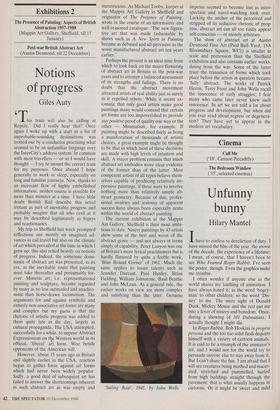Exhibitions 2
Post-war British Abstract Art (Austin Desmond, till 22 December)
Notions of progress
Giles Auty
This train will also be calling at Reptile.' Did I really hear that? Once again I woke up with a start as a list of improbable-sounding destinations was trotted out by a conductor practising what seemed to be an unfamiliar language over the InterCity's address system. In common with most travellers — or so I would have thought — I try to mount the correct train for my purposes. Once aboard I hope generally to work or sleep, especially on long and familiar journeys. Now, thanks to an incessant flow of highly embellished information, neither course is possible for more than minutes at a time. I have little doubt British Rail describe this novel irritant as part of inevitable progress and probably imagine that all who cavil at it may be described legitimately as fogeys and reactionaries.
My trip to Sheffield last week prompted reflections not merely on imagined ad- vances in rail travel but also on the climate of art which prevailed at the time in which I grew up; this also relied heavily on notions of progress. Indeed, the sometime domi- nance of abstract art was presented, in its era, as the inevitable route that painting must take thereafter and presumably for- ever. Mimetic art, i.e. representational painting and .sculpture, became regarded by many as no less outmoded and anachro- nistic than horse-drawn locomotion. The arguments for and against symbolic and entirely non-associative art forms are many and complex but my guess is that the rhetoric of artistic progress was added to them quite late in the day, largely as cultural propaganda. The USA attempted, successfully for a while, to impose Abstract Expressionism on the Western world as its official, 'liberal' art form. Woe betide opponents of the American will.
However, about 15 years ago in Britain and slightly earlier in the USA, reaction began to gather force against art forms which had never been widely popular. Sadly, a good deal of subsequent art has failed to answer the shortcomings inherent in such abstract art as was empty and
meretricious. As Michael Tooby, keeper at the Mappin Art Gallery in Sheffield and originator of The Presence of Painting, wrote in the course of an informative and well-reasoned catalogue: 'The new figura- tive art that was made fashionable by shows such as A New Spirit in Painting became as debased and all-pervasive as the worst manufactured abstract art ten years earlier.'
Perhaps the present is an ideal time from which to look back on the major flowering of abstract art in Britain in the post-war years and to attempt a balanced assessment of its strengths and failings. There is no doubt that the abstract movement attracted artists of real ability just as surely as it repelled others. While it seems ax- iomatic that only good artists make good paintings many would contend that certain art forms are too impoverished to provide any positive proof of quality one way or the other — Minimalism, for example. If painting might be described fairly as being a manifestation of thousands of artistic choices, a great example might be thought to be that in which most of these decisions are made with high levels of intuition and skill. A major problem remains that much abstract art embodies more clear evidence of the former than of the latter. Most competent artists of all types believe them- selves capable of producing relatively im- pressive paintings, if these were to involve nothing more than relatively simple ab- stract geometry. Because of this, profes- sional rivalries and jealousy of apparent success have always been especially acute within the world of abstract painting.
The current exhibition at the Mappin Art Gallery, Sheffield is their most ambi- tious to date. Ninety paintings by 43 artists show some of the best and worst of the abstract genre — and not always in terms simply of capability. Peter Lanyon was one of Britain's more lyrical practitioners but is hardly flattered by quite a feeble work, 'Blue Round Corner' of 1961. Much the same applies to lesser talents such as Jennifer Durrant, Paul Huxley, Brian Fielding, William Johnstone, Basil Beattie and John McLean. As a general rule, the earlier works on view are more complex and satisfying than the later. Genuine 'Sailing Boat', 1945, by John Wells impetus seemed to become lost as intro- spection and navel-watching took over. Lacking the anchor of the perceived and stripped of its seductive rhetoric of prog- ress, abstract art can all too easily appear self-conscious — or merely arbitrary.
The show of abstract art at Austin Desmond Fine Art (Pied Bull Yard, 15A Bloomsbury Square, WC1) is smaller in scale and pretension than the Sheffield exhibition and also contains earlier works, dating from the war. Some of the latter trace the transition of forms which took place before the artists in question became 'fully' abstract. The works of Patrick Heron, Terry Frost and John Wells recall the innocence of early struggles; I fear many who came later never knew such innocence. In art we are told a lot about progress and development, but when did you ever read about regress or degenera- tion? They have yet to appear in the modern art vocabulary.


























































 Previous page
Previous page